4. Be Smart About Carbs
Foods rich in carbohydrates can provide a lot of good nutrients. But compared to fats and protein, carbs have the most significant impact on blood sugar. That's why it's important to choose your carbs wisely and opt for whole grains and low glycemic index foods — carbohydrates that have less of an impact on blood sugar levels — whenever possible.
Diabetes-specific meal or snack replacements, such as Glucerna®shakes and bars, are always a good option. Composed of blends of carbohydrates, designed to minimize blood sugar spikes, fiber, protein and vitamins and minerals, and with up to 250 calories per product, they're a smart, portion-controlled choice to keep in your arsenal.
Related: Better Choices Add Up! Check out the Interactive Snack Swap Calculator
In contrast, foods with a high glycemic index and glycemic load cause blood sugar to rapidly increase, which causes spikes in blood sugar. Aim to limit refined and processed carbohydrates and choose fiber-rich whole foods, such as apples, carrots, beans, and cashews.
5. Pay Attention to Portions
It's not just what you eat; it's how much of it, too. When looking to manage your blood glucose, here are some simple guidelines to keep in mind for healthy portions:
- One cup = a fist
- 3 ounces = palm of your hand
- One tablespoon = thumb
6. Lighten Up
Most traditional holiday recipes can be made healthier with simple substitutions. Instead of rice or mashed potatoes, swap in cauliflower. Use Greek yogurt instead of high-fat sour cream. And sweet potato casserole can be replaced with roasted sweet potatoes for a more diabetes-friendly offering.
For more than 800 additional healthy diabetes holiday recipes and swaps, visit the American Diabetes Association's content hub.
7. Slow Down
Did you know that it takes 20 minutes for your brain to catch up with your stomach and let you know that you're full? Eating slowly can help you recognize that you feel full before you overeat meaning you consume fewer calories. To help slow down your eating, chew slowly, place your utensil down or take a sip of water between bites.
8. You Can Have Dessert, but …
If dessert matters to you, plan for it. Eat fewer carbs beforehand so you can enjoy a piece of pie later. Remember, the pie will probably be high glycemic index carbs, so be mindful of portion size and consider skipping the sugary toppings.
9. Keep on Moving
Although most holiday gatherings revolve around sharing a meal, consider adding more physical activities to the festive agenda. A game of tag or hide and seek outside can be a fun tradition, as can going on a family walk after mealtime.
10. Don't Beat Yourself Up
If a food setback happens, don't give up. "A lot of us can overindulge, despite our best efforts," Kelly says. "Instead of feeling guilty about it, focus on getting back on track at your next meal."
Even when there are tempting goodies around every corner, it's still possible to stay healthy while monitoring blood sugar this holiday. And with diabetes holiday recipes in your back pocket, you can ensure there's always something you can eat guilt-free at the table. So plan, be mindful, and cut yourself some slack, so you can eat, drink and be merry with the best of them.




Social Share